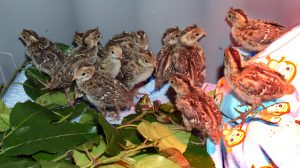Support Us
Since 1979 more than 140,000 animals have been treated by Wildlife Rescue.
Thanks to the support of individuals like you, Wildlife Rescue can provide a lifeline for animals in distress.
Last month, Wildlife Rescue provided supportive care to 17 orphaned California Quail nestlings who were found abandoned in their nest near a construction site in Osoyoos, BC. The finder brought the quail in at the right time or it would hinder their development and survival.
Upon the initial health assessment, Wildlife technicians found the young nestlings were severely dehydrated and lacked important nutrients essential for development. Staff worked hard to ensure the Quail received much-needed warmth and a nutritional diet of seeds, chick mix, and insects so they could make it into adulthood and safely return home.
The large group of quails has been growing and developing slowly over the last few weeks. They have gained weight and are starting to show healthy feather strength. They are not in the final stage of their pre-conditioning release yet but with opportunities to stay in a large enclosure that mimics their natural environment will give them the critical skills they need to be released.

These environments are critical in promoting natural behaviour such as hiding, foraging, perching, and flying so they can survive challenging environments and predators.
Right now, the quail are eating a mixture of corn and wheat mixture, as well as duck row, love lettuce, berries, and mealworms out of trays on the ground. In the wild, quails are ground foragers and will eat plants such as leaves, grain, berries, and acorns, but will also eat smaller insects such as caterpillars, beetles, and snails.
Since they forage on the ground, it makes sense these birds would also nest there. To both avoid predators and stay near their food sources, quails make nests in the grass, often surrounded by rocks, or shaded by a tree – giving them protection. Of course, quails will often take advantage of height as well – some quails make their nests as high as ten feet off the ground.
Wildlife Rescue staff are working with regional biologists to ensure a safe and natural release for the young to their native habitat in Osoyoos, BC in the coming weeks, stay tuned for more!
If you would like to help with the many efforts of the Wildlife Rescue Association, please feel free to make a donation by visiting our site.